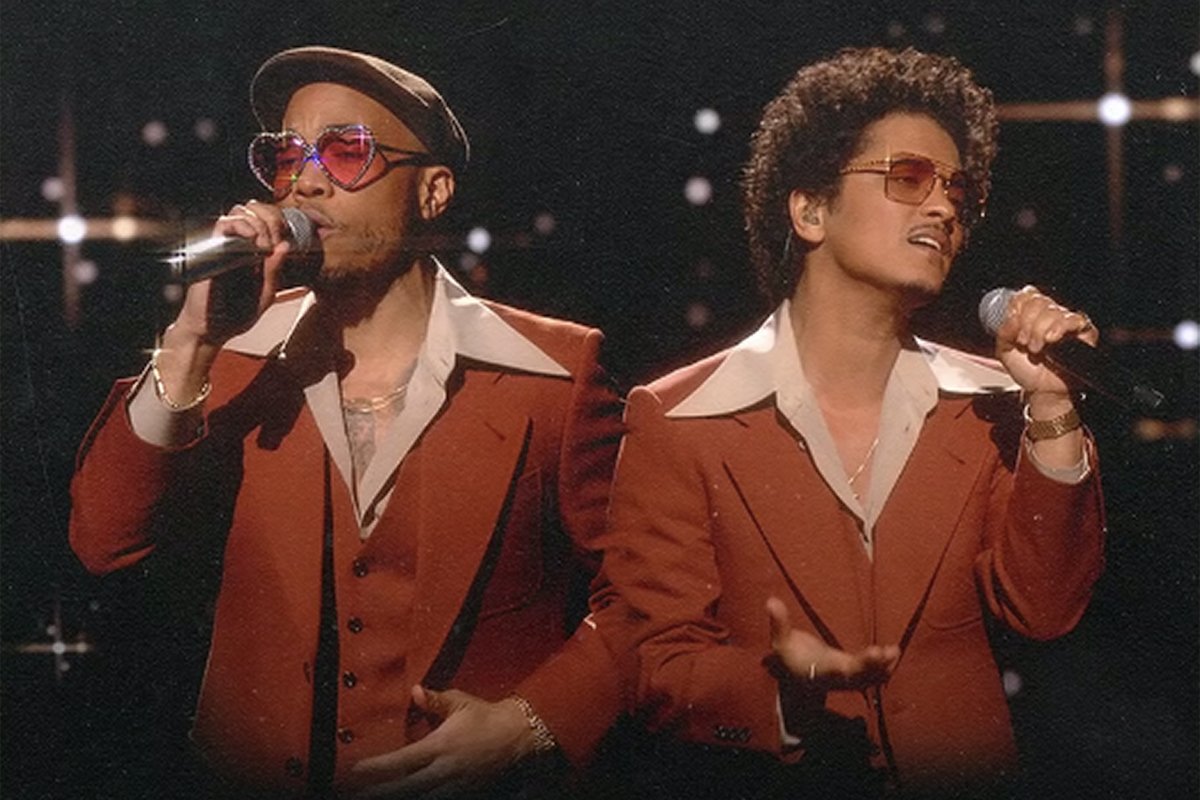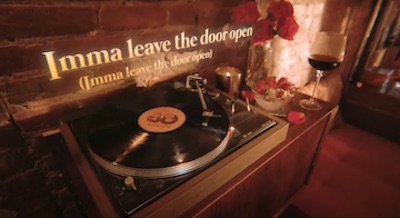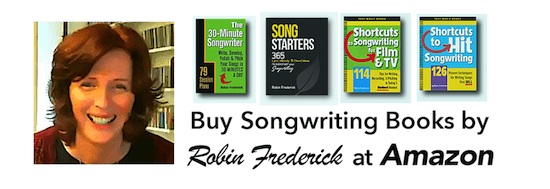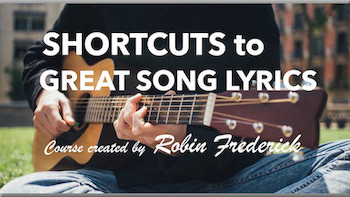This Song Guide is dedicated to all you guys and gals who lived, loved, and danced to the great R&B/Soul hits of the ’60s and ’70s. If you remember Rose Royce, The O’Jays, The Delfonics, and Teddy Pendergrass… you’re gonna love this song.

“Leave the Door Open” has an authentic vintage Soul sound that makes me wanna teeter around the dance floor on platform shoes so tall they give me a nose bleed. At the same time, it has the luscious lyric imagery, cascading rhymes, and rhythmical melody twists that my 2020-era self finds totally satisfying.
It’s a perfect example of a successful blend of styles—old and new—in a mash-up that drove this song to platinum sales and the #1 spot on the Billboard Hot 100 in 2021.

In case you don’t already know: Silk Sonic is the name adopted by super-duo Bruno Mars and Anderson .Paak. They plan to release an entire album of ’70s Soul music. Can’t wait!
SONG GUIDE
TECHNIQUES TO HEAR AND TRY
• Blend old and new lyric styles.
• Give your chorus a time-tested hit melody.
• Stretch out your song structure.
• Blending old and new styles in a production.
Listen to the song. Read the lyrics.
Watch the lyric video on YouTube.
GENRE/STYLE: R&B/Soul
(What is a genre? Watch this video.)
Bruno Mars has always enjoyed combining current styles with past eras as he did in “Locked out of Heaven” (The Police), “Uptown Funk” (1980s Funk band Zapp), and his first hit “Grenade” (Motown). In “Leave the Door Open,” he and Anderson .Paak take a deep dive into the Philadelphia Soul sound of the ‘70s, while dropping in plenty of current songwriting techniques as they go.
This song claimed a top spot on the Billboard Adult Contemporary music chart and the Adult R&B chart, as well as the Hot 100. It appealed to a broad demographic with an emphasis on the 25 to 40 age range. I predict that we’ll be hearing this song for a long time to come. It plays well with both Pop and R&B fans.
WHY TRY A BLEND? If you’re a songwriter or musician who knows an earlier decade like the back of your hand (‘cause you were there), this is the perfect way to show off the skills you already have while mixing them up with new ways of approaching lyrics and melody.
Collaborations between those who were there then, and those who are in tune with what’s new can produce really exciting results!
SONG STRUCTURE
The structure is interesting. Like many R&B/Soul hits, the songwriters play around with traditional construction. So now’s a good time to take a look at the lyrics and listen as you read. Here’s what I think the structure looks like. See if you agree.
VERSE 1a / VERSE 1b / PRE-CHORUS / CHORUS
VERSE 2a / VERSE 2b / PRE-CHORUS / CHORUS
BRIDGE / CHORUS / OUTRO
VERSE 1a opens with “What you doing? Where you at?”
VERSE 1b begins with “My house clean, my pool warm”
PRE-CHORUS: “I ain’t playing no games…”
CHORUS: “Ima leave the door open”
VERSE 2a starts with “Ooh, you’re so sweet”
VERSE 2b opens with “Ooh, baby, don’t keep my waiting”
PRE-CHORUS: “I ain’t playing no games…”
CHORUS: “Ima leave the door open”
BRIDGE ( 2:23): “La-la-la…”
OUTRO: A Chorus+Bridge mash-up starts at 3:15 and runs for 30+ seconds of outro as the song ends. Notice that this song has a fade out. Many of today’s hits have a definitive ending rather than a fade, which was more common in the 1970s.
– Try It Now –
Listen to the song and read along with the lyric. To my ear, there are two verses leading up to each pre-chorus. But the melody in the second verse of each pair is not exactly the same as the first. It rises at the end, building to the pre-chorus. Then the pre-chorus melody builds up even more energy going into that big chorus. Listen and see if you can feel the energy being pumped up. It’s kind of like a ’70s R&B ballad on steroids.
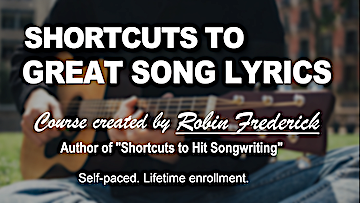
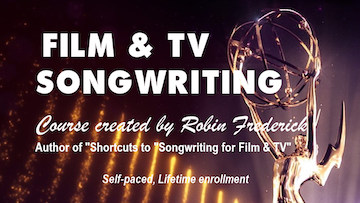
LYRICS
KEEP IT CONVERSATIONAL: The lyric opens with the singer on the phone trying to talk a girl into coming over. It’s conversational and sets a realistic tone. Listeners love to feel they’re eavesdropping on a real conversation. Adele used this very effectively in her mega-hit “Hello.” It’s a device that can trace its Rock roots all the way back to the Big Bopper’s “Chantilly Lace” in 1958.
USE IMAGES TO SET THE SCENE: In the opening two verses of the song, the writers establish a location and a character that engages the listener. It’s easy to imagine the action and get a feel for the singer’s personality.

I’m sipping wine / in a robe
I look too good / to be alone
My house clean / my pool warm
Just shaved / smooth like a newborn
GIVE YOUR MAIN CHARACTER PLENTY OF APPEAL: At this point, the listener might be forgiven for thinking the singer is more in love with himself than the girl he’s talking to. We never want listeners to feel that the singer is egotistical (a negative personality trait), so the pre-chorus has to turn that around.
I ain’t playing no games
Every word that I say is coming straight from the heart
Try to stay ahead of your listener. Anticipate what they might think of the singer or questions that might have. If your singer says something that could be a turnoff for listeners, be sure to offer an explanation or more information that justifies it. You want listeners to identify with and relate to your singer. This is as true now as it was in the ’70s.
Find out more about adding characters to your lyrics.
USE CONTEMPORARY RHYMES: The rhyming style of Rap songs has influenced the way all genres of songs use rhyme today and this one is no exception. It’s a tightly-packed, rhythmical rhyme style that encourages fresh, multi-syllable vowel rhymes. You’ll hear it in “Leave the Door Open” just before each pre-chorus. Listen for a quick cascade of rhymes that adds a sense of lightness and energy.
VERSE 1b: dancin’/ romancin’ / mansion / what’s happenin’
VERSE 2b: cuddlin’ / let’s jump in / it’s bubblin’
There are also single syllable rhymes that take advantage of the loose vowel-rhyme style. In Verse 1a, you’ll hear at / plans / that / trap, all in quick succession.
WHAT ABOUT ALL THE LA-LA AND WOO-WOO? There’s a lot of vocalizing with non-word syllables in this song, especially in the bridge. While the approach to rhyming is contemporary, the extensive use of “la-la” and “woo-woo” vocals was more prevalent in the late ’60s and early ’70s than now. Check out The Delfonics 1967 hit single “La-La Means I Love You” to hear a cut with plenty of it.
Today’s R&B songs are often filled with wordplay, but very little room for non-word syllables. Listen to Ella Mai’s “Trip” to hear a good example of this contemporary style.
– Try It Now –
Try a blend of lyric eras in a song of your own. Mix today’s creative, multi-syllable vowel rhymes and image-driven lyrics with a familiar theme and character from the hits of the 1970s. If you’re writing in the R&B/Soul genre, leave plenty of room for non-word vocalizing.
MELODY
In “Leave the Door Open,” the verse melodies are filled with chatty rhythm as the singer tells us about his mansion, the wine, and the rose petals in the bathtub. The use of a a lead vocal answered by background vocals is a great way to create momentum and fill space, and is characteristic of the R&B/Soul sound.
The pre-chorus lifts just as it should, opening out into a smooth, melodic chorus with plenty of room to stretch out. After the busy verses, the simple repetition at the top of the chorus works well.
A SOLID CHORUS MELODY: The chorus melody is the star here. It’s got plenty of repetition, making it easy to remember. Yet it creates surprises in all the right places, keeping things interesting for the listener.
The smooth opening line is repeated in Line 3 and echoed by the background vocals in Lines 2 and 4.
I’ma leave the door open
(I’ma leave the door open)
I’ma leave the door open, girl
(I’ma leave the door open hoping)
If those lines were repeated another time, the melody could become predictable. So the line that follows is delivered in short, staccato bursts creating lots of attention-getting rhtyhmic contrast.
That you feel the way I feel
And you want me like I want you tonight, baby
Then the payoff (final) line of the chorus returns to the smoother feel of the opening lines.
– Try It Now –
This melody structure—repeating a melody twice before going to a line with plenty of contrast in phrase length and note pace—is a time-tested winner with listeners. Give it a try in one of your own songs. It works in all genres and eras.
Bruno Mars loves the R&B genre and he loves to blend the old with the new. For another example of a Bruno Mars hit in which he created an R&B blend with elements of Smokey Robinson and Motown in the melody and chords, check out my Song Guide for Bruno’s hit single “Grenade.”
CHORDS for “Leave the Door Open”
This song features a stone-cold classic chord progression in the style of the great R&B/Soul hits of the early ’70s. Mars and Paak have obviously immersed themselves deeply in this genre.
The number and type of key changes and their location in the song closely parallels ’70s hits like “Didn’t I (Blow Your Mind This Time)” by The Delfonics.
This kind of chord progression, with multiple key changes and passing chords, is a world away from today’s more repetitive progressions. If you’re a fan of the R&B/Soul genre, progressions like these are probably imprinted deep in your lizard brain. If the style is new to you, I recommend learning some chord progression theory before you take it on.
Here’s a video on YouTube that will walk you through the song’s key changes and explain some of how it works in language you can understand even if you don’t know anything (or very much) about music theory.
If you’d like to play along with “Leave the Door Open,” you’ll find the chords here. Good luck!
PRODUCTION TIPS: R&B/SOUL BLEND
THE DIFFERENCE BETWEEN THEN AND NOW: Of course, there will always be great singers and musicians. That will never change. (Thank goodness!) But many other things have changed since the heyday of the R&B/Soul greats, especially in the area of recording and mixing.
When blending styles, one of your biggest challenges will be maintaining the live quality of earlier decades while working, often on your own, creating parts one at a time in a control room or home studio.
Here are a couple of tips.
* Try to record live, complete takes as often as possible,
* Bring in other musicians to work with you.
* If you can’t afford to bring in musicians, approach the parts as if you’re playing each one with the band. Keep a live vibe going in your performance.
HOW AUTHENTIC DO YOU WANT TO BE? If you want to keep your sound authentic, avoid using too many plug-ins in your mix, especially reverbs. Many of these songs were recorded with all of the musicians present in a single room, including the string section and horns. Multiple reverbs suggest rooms of different sizes. Choose a room reverb that’s the size you want and stick with it.
“Leave the Door Open” is a beautifully recorded and mixed R&B/Soul song, but it is not trying to achieve the authentic sound of the 1970s. If you’re creating a musical blend of past and present and you want to appeal to today’s audiences (even older audiences), this is one of those areas where you might want to live in the now.
– Try It Now –
Check out some of the successful bands and artists who are mixing different eras into their music: Cage the Elephant, Bruno Mars, Neon Trees, The Black Keys, Black Rebel Motorcycle Club, and Eilen Jewel. These are just a few. Have fun digging for more!
